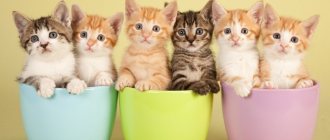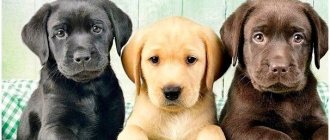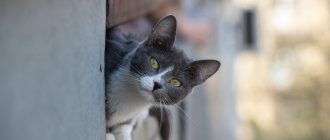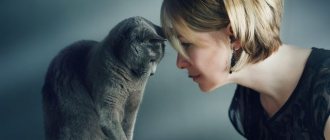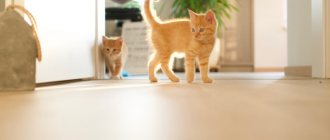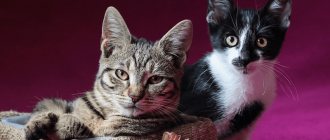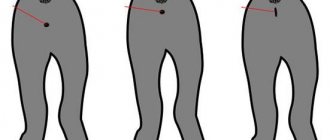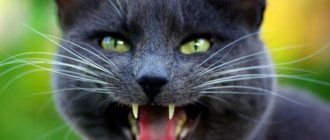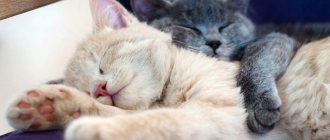Every cat owner considers his own pet to be the best, most beautiful and unique. The owner of a purebred kitten has reason to be proud of his aristocratic origins and corresponding pedigree.
Those who have an ordinary mongrel dog slumbering at their side can only be consoled by its devotion and wonderful character. However, the owner has the opportunity to classify his mustachioed cat independently as a breed.
It can be determined by the appearance of the animal. The dimensions of a cat, the size of its ears, the length of its paws and tail, as well as the texture and color of its fur can tell a lot to an inquisitive observer.
Why determine the breed of a kitten and when is it necessary?
Each cat breed needs an individual approach
The question of how to determine the breed of a cat is asked by those who have picked up a furry animal from the street or adopted it from a shelter. Having purchased a pet from breeders or in a nursery, the new owner is given all the relevant documents for the animal, including the breed of the cat.
First, let's define the breed. The ancestor of domestic cats is the wild forest cat. All of their subsequent varieties were bred by selection, that is, created by the methods of crossing and artificial selection. Therefore, animals have appropriate standards. At the same time, cat breeds have their own characteristics in the form of the shape of the head, ears, paws, length of fur, color, color and position of the eyes. Each breed has its own character, strengths and weaknesses.
Currently, there are more than 200 breeds of domestic cats and cats.
Many animals have clear signs of belonging to one breed or another and the owner will have no doubts, but this is not completely clear with all pets.
Determining the cat's breed is an important part of ensuring proper attention and care for the animal.
Breed influences the following factors:
- Genetic predisposition to diseases of some breeds.
- Monitoring the development of the animal, based on its breed, including the beginning of teeth change, puberty, and the beginning of complementary feeding.
- Know the nature of the animal’s habits based on its breed in order to form its habits, reflexes and to establish contact.
- Selection of a pair for breeding offspring.
- Food choice.
The Maine Coon breed develops more slowly, unlike average and ordinary cats.
The health of purebred cats is weaker than domestic or wild ones, since in the selection process the main task is to consolidate some external characteristic of the animal in the process of natural selection and health is not always taken into account.
It makes no sense to determine the breed of an animal earlier than four months after its birth, since the kitten is just being formed, the color has not properly developed, and the eye color changes up to six months.
Pedigree cats and mestizos
Each breed has a number of distinctive character traits, but these are generalized characteristics and do not provide a 100% guarantee that your pedigree cat will fully correspond to its breed. Contrary to popular belief, there are active Persian cats, sphinxes who are afraid of water, calm and leisurely shrouds and aggressive bobtails.
What matters is not what breed the cat is, but how you show love and care for it. Believe me, she will definitely reciprocate. Even the most ordinary yard cat can become a hero and a loyal friend for a person.
If you find a kitten on the street and cannot determine its breed, do not rush to leave it there. It is better to take him to the nearest nursery, where he will be taken care of and perhaps even found a loving family.
The main differences between purebred pets and domestic ones
Yard cat
There are about six hundred million cats on planet earth. This also includes wild, domestic and purebred animals. Pedigree cats make up about 10% of the total number. But they have their own characteristics.
The main determinant of the breed is the relevant documents for the animal:
- Veterinary passport of the animal indicating the vaccinations received;
- Metrics (birth certificate) indicating the breed, date of birth, name, breeder;
- Pedigree, indicating the parent (for breeding);
- Purchase and sale agreement (optional).
Pedigree for a purebred cat
Veterinary passport
Metrics
And without the appropriate documentation, the difference between a purebred cat and a barn cat can only be a misconception, since sometimes a cat with a pedigree is less similar to a representative of its breed than one who runs around the yard without a homeland and a flag.
But to properly care for the animal, you can try to determine the breed by external features, such as ears, skull shape, color and shape of the eyes, since each representative has its own special feature.
Outbred cats have small distinctive features and, as a rule, only in color, and their appearance is similar.
The main features of outbred cats:
- The physique is correct and proportional, medium size - up to 46 cm without tail;
- The ears are set straight up in a triangular shape of medium size;
- The head is round, the muzzle is slightly extended forward;
- Paws are long, of medium thickness;
- The eyes are round in normal position;
- The tail is long and straight.
However, purebred cats have their own obvious characteristics.
Ear shape.
It is one of the most prominent and characteristic features for a number of breeds.
Fold-eared cat types, when the ears are slightly turned out and the tips of the ears are directed downwards, include such cat breeds as the Scottish Fold shorthair and longhair, the British Shorthair, and the Ukrainian Levkoy.
Scottish Shorthair Fold
Ukrainian Levkoy
The breeds that have inverted ears, where the tips point backwards, are the American Curl, Highlander, and Elf.
American Curl
Representatives of the Maine Coon breed have large ears with tassels at the tips, while Savannah, Kanaani and Daven Rocks have large and wide ears. Huge disproportionate ears are characteristic of Oriental cat breeds and Abyssinians.
Savannah
Abyssinian cat
Head shape
The skull is also a distinctive feature of purebred cats.
The round shape of the skull and flattened nose are the main characteristics of such breeds as Persian cats, exotic shorthairs, Scottish folds, and British shorthairs.
Exotic shorthair
An elongated muzzle is characteristic of the following breeds: shorthaired Oriental, Abyssinian, Egyptian Mau, Havana, Siamese, Japanese Bobtail, Thai, Sphynx.
Egyptian Mau
Oriental Havana cat
Eye shape and color
Round and large eyes give special cuteness to such breeds as Scottish, British, Devon Rocks, Singapura, Ukrainian Levkoy, Ragdoll and Persian and exotic cats.
Devon Rocks
Singapore
Blue eye color is a distinctive feature of such breeds as: Oriental longhaired and shorthaired, Siamese, Turkish Angora, Thai, Bilanese, Burmese, Javanese, Ojos Azules.
Angora
Burmese cat
Also, cats with white fur usually have blue eyes.
Look where your ears are pointing
This is another trait by which a purebred cat is identified. So, for example, ordinary yard cats have ears that are pointed and point upward. Thoroughbreds often have an original shape, as well as direction or location relative to each other.
Forward-curved ears are a characteristic feature of:
- lop-eared British;
- Scots;
- Highland Fold;
- skcottish fold.
In the American Curl they are curved back.
The ears have an unusual shape:
- Poodlecat. Has large, floppy ears.
- Ukrainian lefty. The ears are almost invisible, as they are curled into a tight tube.
Some breeds are distinguished by the size of their ears. The largest ones have:
- Siamese cats;
- oriental;
- sphinxes;
- Peterbalds.
Maine Coons have ear tufts. And Siamese have dark fur on them.
When choosing, pay attention to the condition of the auricle. In a healthy animal it is clean, without purulent deposits.
How to determine cat breed by size
Maine Coon and Burmese
The size of simple domestic cats is standard: up to 46 cm long, tail approximately 20-30 cm. The weight of such cats is from two to four kilograms. The cats are a little larger – from four to six.
Pedigree cats have a completely different range in size and weight. Some representatives of the breeds can weigh up to 15 kg, while others do not exceed two.
Large
Large breeds of animals are the most noticeable, as they sometimes look like real wild predators. Breeds of large cats and cats are presented in the table below:
| Breed | Length | Weight |
| Turkish van | 100-120 cm with tail | From 6 to 10 kg |
| Maine Coon | Up to 100 cm with tail | From 4 to 8 kg |
| Bobtail | From 50 to 60 cm at the withers | From 4 to 9 kg |
| Savannah | Up to 60 cm at the withers | Up to 15 kg |
| Siberian | Up to 40 cm at the withers | From 8 to 15 kg |
| British | Up to 40 cm at the withers | From 5 to 8 kg |
Turkish van
Kurilian Bobtail
Weight and size, among other things, depend on the sex of the animal, as well as on sterilization and castration. Males are larger than cats and can differ in weight by several kilograms and ten centimeters. And after castration or sterilization, male cats can gain a couple of extra pounds.
Mr. Cat recommends: Online locator
Today, in the age of the ubiquitous Internet, to determine or clarify the breed of a pet, you can turn to “online identifiers”.
These virtual assistants are tables that systematize the breed characteristics of a wide variety of cat representatives. Simply by answering the questions posed using logical chains, you can determine whether the animal is purebred and which group it belongs to.
In this case, it is advisable to evaluate an adult animal; it is impossible to test a newborn here. The kitten needs to mature for at least six months in order for its breed characteristics to appear.
Little ones
Dwelf
Among the representatives of exotic breeds there are also completely small or even tiny cats. For a better understanding of their size and weight, we also present them in the table:
| Breed | Length at withers | Weight |
| Lambkin | From 17 to 20 cm | From 2 to 5 kg |
| Bombino | From 17 to 20 cm | From 2 to 4 kg |
| Skookum | From 22 to 25 cm | From 1.5 to 3 kg |
| Munchkin | Up to 20 cm | From 1.8 to 2.7 kg |
| Dwelf | From 20 to 25 cm | Up to 3.5 kg |
| Singapore | From 18 to 22 cm | Up to 3 kg |
| Minskin | Up to 20 cm | From 2.5 to 3 kg |
Lambkin
Bombino
There are similar differences between male cats and female cats. Cats are larger by several grams, and sometimes even a kilogram. The table shows the minimum and maximum sizes and weights for both genders.
Determining the breed by external differences
In addition to eyes, ears, head shape, as well as size and weight, some representatives of various breeds have their own peculiarities in the structure and shape of the tail, paws and body.
Such signs are no less important for determining and matching to a particular breed.
Small tail
American Bobtail
A short tail is a sign of the breed, unless, of course, the tail was lost through physical contact. The tail can be really short, or it can be curled and curved.
The Manx breed has the shortest tail. It seems that this breed has no tail at all.
The Japanese Bobtail breed's tail is no more than 6 cm long, and the American Bobtail's tail is no more than 10 cm long.
Cymrik also has a short tail from 1.5 to 8 cm. But the average length is 3-4 cm. The pixie-bob breed has a tail of about 5 cm.
Cymric
Pixiebob
Interesting: the tail of a domestic cat is on average 30 cm
Short legs
Munchkin
Ordinary wild and domestic cats have long and thin paws. All representatives of short paws are bred by selective breeding.
There are only a few breeds of cats with short legs: Minskin, Dwelf, Munchkin, Napoleon, Bambino, Skookum, Kinkaloo, Lamkin, Genetta, Minuet, Chinese Tank, Munchaymose and Scottish Fold Munchkin. The front legs of these animals are slightly shorter than the hind legs. Moreover, the Munchkin is considered the first of the short-legged representatives that were the result of a mutation, but all other breeds were bred artificially. Kinkalow was the first to experiment with crossing the Munchkin breed and the American Curl breed.
Kinkaloe
Minskin
Cats with short legs look cute and funny, however, the animals have difficulty moving, and this mutation or selection characteristic weakens the health of the animal.
The 20 most common cats in the world
Every year, the Cat Fanciers' Association (CFA) compiles a ranking of the most popular cat breeds. It is based on the volume of official registrations of purebred cats. So, according to the latest data, more than 2 million individuals are registered with the CFA, belonging to 42 breeds recognized by the corporation.
This time the ranking consists of 20 breeds, which are listed in the table below from last to first place.
Table 2. The most popular purebred cats according to CFA
| Name | Origin | Description |
| Exotic cat | The breed was created in the 1960s after crossing a Persian cat with an American Shorthair | Wide stocky body, large paws. The coat is velvety and thick. Cats are calm and affectionate |
Persian cat | The breed originated in Persia, which is now called Iran. In the 17th century it was brought from there to Italy. In 2012-2013, it confidently took 1st place in the ratings, but later lost ground | Dense body, legs short and thick. Round massive head, snub wide nose. The coat is silky and thick |
| Maine Coon | The ancestors of modern Maine Coons lived on farms in Northeast America. The name comes from Maine, where they were common. Local farmers associated them with raccoons due to their dark striped color, so they added an additional part of the name - "coon" (literally "raccoon") | A giant cat with large eyes, a fluffy tail and long hair |
Ragdoll | The ancestors of the Ragdoll appeared in California from a mixture of Burmese and Angora cats. The name comes from the peculiarity of this breed: cats completely relax in your arms and allow you to do whatever you want with them. | Large cats with long hair and a bushy tail, round blue eyes |
| British shorthair cat | The first purebred Briton was bred in Great Britain in the 19th century | Massive cats with a strong body, small paws and “plush” fur. The eyes are large and protruding |
American shorthair cat | Appeared in North America thanks to the first immigrants from Europe, who brought cats on ships | Strong slender body, hard thick hairs. Round head, eyes wide open. These are independent and active cats. |
Scottish fold cat | The first representative of the fold was discovered in Scotland in 1960. It was a mutated English shorthair cat | The main feature is a gene mutation that results in “broken” cartilage in the ears |
Abyssinian cat | The oldest breed that began its journey from Ethiopia. According to legends, cats of this type were worshiped in Ancient Egypt. Some breeders suspect that the blood of reed wild cats may flow in the veins of Abyssinians | Refined elongated body, thick undercoat, triangular head with deep oval eyes. Unusually colored hairs with ticking |
Canadian Sphynx | Documentary recognition befell the sphinxes in 1966 in Canada. However, some historians claim that representatives of the breed were popular even during the reign of the pharaohs in Egypt and the Mexican Incas | Heavy body of medium size, triangular head. Prominent cheekbones and mustache pads, deep-set eyes |
Oriental shorthair cat | They were brought to Europe along with the Siamese at the end of the 19th century. The ancestors of Oriental cats lived in Thailand. The breed was finally recognized in the 70s simultaneously in the states and in England | An elongated, strong body with a long, sharp tail. Small paws, wedge-shaped head. The color is similar to “Siamese”, but without a clear color-point pattern |
Devon Rex | A cat of this breed was first noticed in Great Britain in 1960. One of the local residents managed to tame a wild pregnant cat, which gave birth to charming wavy kittens | A fragile but muscular body with curly silky hairs, huge ears. Wide head with thin graceful neck |
| Siamese cat | Siamese cats first appeared in Siam (modern Thailand). From there they were brought to Europe by the English consul, where they were bred for about 200 years | Flexible, thin body, the front legs are slightly shorter than the hind legs. Characteristic “Siamese” color, bright blue eyes, large ears |
Cornish Rex | The breed was developed in Great Britain in 1950. Later, unusual kittens were crossed with Burmese and British, after which the breed was officially recognized | A small cat with a refined body, a curved back, and large ears. The main feature is long wavy hair |
Norwegian Forest Cat | The breed was bred in Norway. The ancestors of modern Norwegian cats served as assistants on Viking longships | Massive body with long waterproof hairs, triangular head with a flat nose. There are tassels on the wide-set ears, and a voluminous collar on the neck. |
Sacred Burma | The breed was bred in France in the 20s of the last century. In Burma (Myanmar) they were sure that the souls of dead monks lived in these cats, and they were kept in Buddhist monasteries | It has light long hair, pointing colors, characteristic of Siamese cats, and light “socks” on the tips of its paws. There are dark markings on the muzzle, joints and tail. The Burmese has large limbs and a massive body. Their temperament is calm, they are quick-witted and inclined to learn. |
| Russian blue | The breed began its development since the times of Old Slavonic times. Outside Rus', they learned about her in 1893, when one of the cat fans took several charming kittens from Arkhangelsk | This is one of the most expensive cats in the world. Has short bluish fur that shimmers with an amazing silvery tint. |
Tonkinese cat | Bred in Vietnam. The breed was the result of crossing Siamese and Burmese cats | Well-developed muscles, slender body, slanting, expressive eyes that change color. High cheekbones and well-shaped muzzle |
Siberian cat | She was born in Siberia in 1988. She is considered the pride of Russian felinology | Medium massive body with thick waterproof coat, strong paws. Large round eyes |
Burmese cat | The first chocolate-colored cat was brought to the states from Rangoon in 1930. There she was crossed with a Siamese cat. From this union came two branches of the Burmese - American (heavier) and British (graceful) | Short silky hair, small body. Cats are muscular and strong. They have large, wide-set eyes |
Ocicat | The first cats of this breed became known in 1964 in the USA, and reached Europe only in the 1990s | They have an animal coloration, but are considered completely domestic. They can be small or large in size, with a lean body and elongated legs. Short, dense coat with spots |
We suggest you read: How to make a house for a rabbit with your own hands
Features of wool as a criterion
The coat of rumbling predators consists of guard hairs - long with a pointed tip, they can have different thicknesses and lengths, and downy hairs. Downy hair, in turn, is thin, short and often wavy, which acts as an undercoat.
A purebred cat can also be identified by the characteristics of its coat. Some breeds have long hair, some breeds have short hair, and some even have curls or no hair at all.
Long wool
Siberian cat
Long hair in cats is a process of mutation. By default, nature awarded cats with short fur for ease of hunting and survival.
The felinological organization has established more than thirty breeds of long-haired cats.
Bearers of luxurious long fur are the following breeds:
- British Longhair cat;
- American Curl, a distinctive feature is also the inverted ears, the tips of which point back;
- Chantilly;
- Long-haired Burmilla, which also has a snow-white coat and blue eyes;
- Himalayan cat, with a flat face;
- York chocolate cat;
- Somali;
- American and Kurilian bobtails with short tails;
- Maine Coons, with their characteristic ear tufts;
- Persians;
- Neva Masquerade;
- Norwegian Forest Cat;
- Burmese;
- Siberian;
- Turkish Angora and Turkish Van.
Somali cat
Norwegian Forest Cat
In the 15th and 16th centuries, long hair was considered a sign of nobility, and such cats came under royal patronage.
Short hair
British shorthair cat
Cats have had short hair for over 50 million years. It is much easier to care for short hair, both for the animals themselves and for their owners, than for long hair.
The most famous representatives of the short fur coat are:
- British Shorthair cat;
- Oriental Shorthair;
- Russian Blue;
- Safari;
- Siamese;
- Scottish cat;
- American Shorthair;
- Bengal;
- Burmese cat;
- Egyptian Mau
- Thai, who also has bright blue eyes;
- Singaporean,
- Ceylon cat;
- Exotic, similar to a plush toy with a flat nose;
- Abyssinian, with large ears and other breeds.
Ceylon cat
American Shorthair
Most of all cat breeds have short hair. The shorthair gene is active and stable.
In curls and without hair
Another distinctive feature of the breed is the curly coat or lack thereof. Both of these traits are the result of mutation.
The curly coat of a cat is a mutation and indicates the presence of the rex gene, which causes the coat to curl. All representatives with curly or wavy hair are classified as the "Rex" type. It is believed that the first representative of this mutation was noticed in the middle of the last century. And then breeders began to crossbreed mutation cats and male cats and produce new breeds with curly fur.
Cornish Rex
These representatives include the following cat breeds:
- The Cornish Rex is the first representative of this breed to have thin, long legs;
- Devon Rex, German Rex - have short curly fur and long thin legs;
- The Selkirk Rex is a long-haired, wavy wonder;
- Laperm also has a long curly coat;
- Skookum, which has not only curly fur, but also short legs;
- The Ural rex, first seen in Russia in the vicinity of the Sverdlovsk region.
Ural rex
Selkirk rex
No less curious representatives of a number of breeds are cats that are hairless. Although not all of them are actually completely bald. The history of hairless cats begins before our era and the basis of this characteristic is mutation. However, registration of hairless cats began in the late 20th century.
Kohana
Their representatives include such breeds as:
- Peterbald, which is the result of crossing the Don Sphynx and an Oriental cat. The birthplace of such a cat is St. Petersburg;
- Kohana means "bald" in Hawaiian. The skin of these representatives is wrinkled and there is no hint of hair at all;
- Minskin, in addition to the lack of a fur coat, has short legs. Feels like velvet;
- Bambino also has short legs;
- The Don Sphynx, which appeared in Rostov-on-Don back in 1980 as a result of the accidental birth of a hairless kitten;
- Dwelf, which has, among other things, ears turned back and short legs;
- Ukrainian Levkoy, which appeared as a result of crossing the Don Sphynx and the Scottish Fold cat. As a result, the cat has a bald body and ears bent forward;
- Canadian Sphynx with an abundance of folds and wrinkles;
- Elf, who received this name due to his ears bent back.
elf cats
Peterbald
Hairless cats require special care, as they get colder, dirt gets stuck in their folds, and they sweat. Therefore, they must be provided with timely hygiene and warmth.
Inspect the wool
Among the felines you can find both long-haired breeds, those without hair at all, and even with luxurious, curly fur.
Long-haired ones include:
- Burmese. Pets with long, fluffy hair, the characteristic feature of which is easy combing.
- Himalayan cats. This is a cross between Persians and Siamese. They have a large, strong build, typical of Persian breeds, and the color of Siamese cats.
- Maine Coons. They have long, coarse fur and a bushy tail.
- Napoleons. Animals with a medium build and a medium-sized, but very fluffy tail.
- Norwegian forest. The owner of an unusual fluffy collar and paws, the fur on which resembles pants.
- Persian. The most famous representatives of long-haired pets.
- Turkish Angora. A cat with unusual snow-white fur.
Curly breeds include:
- La perm. The color resembles an ordinary yard cat, but the fur of representatives of this breed is very curly.
- Rex. Unusual, curly Czech cat.
There are animals without hair at all, or with a very small amount. This:
- Don Sphynx;
- bambino;
- Ukrainian Levkoy.
When choosing a kitten from a breeder, you should first of all pay attention to the condition of the coat. In a healthy animal it is dense and shiny.
Finding out the breed by color
Siamese cat
The distinctive features of the breeds include, among other things, their individual color. For a number of breeds, color is a calling card.
The most popular and outstanding breed is the Siamese color. It is actively distinguished by its black muzzle and ears, on the tail and paws. The rest of the fur is light in color. However, this color is also typical for the Thai, Himalayan, and Neva Masquerade cat breeds.
During the selection process, cat breeds acquired similar colors: Balinese, Persian, Burmese, Ragdoll, British.
Ragdoll
Balinese cat
Interesting: all representatives of this color have blue eyes.
Blue or gray color. Bearers of a pleasant, iridescent monochromatic color are such cat breeds as Russian Blue, British Shorthair, Korat, Nibelung, Oriental, Scottish and others.
Russian blue cat
Korat
The sandy color is characteristic of the Abyssinian and Somali cat breeds.
Abyssinian cat
Such cat breeds as the Bengal cat, Siberian, Egyptian Mau, Kurilian bobtail, Safari, Caraquet, Savannah and others have a natural, so-called “wild” color. A characteristic feature of this color are clear spots, like those of a leopard or bright stripes of predatory inhabitants of the planet.
Caraquet
Bengal cat
Brown color is very rare and is almost non-existent in the wild. Bearers of a chocolate coat are: British cat, oriental cats and cats, Burmese, Scottish, Abyssinian, Persian and others.
Burmese cat
By appearance
The easiest way to recognize a cat's breed is by its external characteristics. The color and quality of the coat, size and build are different for each cat, but in some cases very similar. Outbred cats are almost all similar to each other: medium body size and rounded head.
© shutterstock
For example, the Russian Blue and British breeds are similar in coat color, but their physique is significantly different. Therefore, to determine the breed of a cat from a photo, you need to try very hard.
Features of pedigree kittens
Exotic kitten
To determine the breed of a kitten, you need to pay attention to a set of characteristics. However, before the onset of 4 months, the characteristics of the breed may change; coat color, proportions, and eye color continue to change up to six months.
What you need to pay attention to to identify the breed.
Body type:
- A large head, stocky body, flat nose may indicate that the kitten belongs to the Persian, Scottish or British breed;
- An elongated muzzle, thin long legs and a slender body may be a sign that the kitten belongs to the Siamese, Angora or Balinese breeds.
- A large build, heavy weight, and late development may indicate that the kitten is classified as a large breed of cat, such as Maine Coon, Turkish Van and others.
Persian kitten
Wool:
- Long-haired;
- Shorthair;
- Rex;
- Bald.
Based on the characteristics of the coat, a kitten can be classified as a particular breed if there are other characteristics. A hairless cat can also be born to a domestic cat - this is an optional sign to classify a kitten as a purebred hairless cat.
American shorthair kitten
Coat color (color):
- plain blue (gray) or chocolate can indicate belonging to a number of breeds that are carriers of this color. The most popular: British cats, Russian Blue, Burmese and others.
- Tortoiseshell color is gray or golden. It can also be owned by yard cats, but in British or Scottish cats it is more pronounced.
- Many representatives of purebred cats have the Siamese color. It is characterized by dark tips of the paws and tail, as well as the nose and ears.
Scottish Shorthair (Scottish Fold) tortoiseshell color
Eye color. At birth, all kittens have dark eyes with a blue tint, and the color changes almost up to six months.
- White-haired cats have blue eyes, as well as Siamese-colored cat breeds such as Siamese, Thai and others.
Balinese kittens
Ears. They also form from 2 to 6 months.
- Small ears with drooping, forward-curved tips may be a sign of fold-eared cat breeds;
- Representatives of breeds such as the American Curl, Elf, Kinkalow have ears where the tips are curved back;
- Oriental and Abyssinian cat breeds have large ears.
Scottish fold kittens with mother
Oriental breed kitten
The signs of the breed will appear in adulthood, however, no matter what breed the owner classifies them with his observations, without the appropriate documents it will be just a guess. But based on this, it will be possible to adjust the animal’s nutrition and care.
What are the advantages of buying a purebred cat?
Information about breed standards is useful when buying a pet - they protect against fraud, because rare animals are much more expensive than common ones, and even more so out-of-breed animals. But why might you need to purchase a “purebred” cat? Compliance with all standards and the presence of a pedigree confirming the thoroughbred nature of the parents “opens the door” to prestigious clubs and exhibitions. Participation in them increases the status of the pet, so the kittens that appear as a result of mating with him will cost a lot of money.
Breeding cats allows owners to make a profit, since purebred kittens of rare breeds cost a lot of money
If a cat only has the traits of a certain breed, and does not have a pedigree (at least the first generation), then it is considered out-bred, but “phenotypically similar” to a Siamese, Persian or other animal. He is not allowed to breed purebred kittens.
Another advantage of knowing the exact breed of the kitten you are purchasing is maximum information about its habits. By getting a mongrel animal, you are buying a “pig in a poke” - only time will tell what its temperament will be, how it will interact with its owners, children, and other animals. A long-term study of representatives of one group made it possible to draw up a “portrait” of animals - starting with their preferences, activity, friendliness and ending with predisposition to diseases. Of course, all these characteristics are quite average (after all, character also depends on upbringing, and health on living conditions), but in general terms the description always coincides.
Advantages of mongrel cats
Outbred and street animals are not the same thing. The first category includes any cats that do not meet the standards. Either nothing is known about the origin of the kitten’s parents, or its mother and father belong to different breeds, the crossing of which is prohibited by standards (that is, as a result of mating, the offspring of mestizos is obtained).
The advantage of outbred animals is their better health. The fact is that when developing a new breed, crossbreeding is initially carried out among relatives - this often leads to genetic defects. In addition, traits that interfere with the normal functioning of the animal can be artificially fixed (for example, too short paws provoke pathologies of the spine and joints).
Is an animal without documents a purebred animal?
A cat without documents can participate in domestic cat shows
Formalities are important. A cat without documents is automatically outbred, no matter what characteristics of a particular breed it may have.
Each breed and its representatives are included in the register of breeds of a felinological organization, which fixes standards for a particular breed, registers cat breeds, monitors the work of nurseries, and also monitors the organization of cat and male exhibitions.
Representatives of purebred cats in nurseries and breeders are registered with a felinological organization and have the following documentation:
- generic metric;
- veterinary passport;
- pedigree.
When purchasing an animal from a nursery or from a breeder, it is also recommended to draw up a pet purchase and sale agreement.
A cat breed can be determined by a felinologist.
If it so happens that the owner got the purebred miracle by accident, and there are no documents for it, then there is a difficult path to assigning the breed to the animal.
- Contact a felinological organization to have your pet examined by a specialist felinologist. If the animal meets the standards of a particular breed, the organization will issue and issue an appropriate certificate. From there you can begin to draw up a primary pedigree for further breeding of offspring.
- Participation in the exhibition of domestic cats. When contacting the organizers, the cat will be examined and an examination will be carried out to determine the breed. After which you can engage in experimental breeding, without a certificate.
Why can a cat be left without a pedigree?
- Breeding animals may produce offspring that do not meet the breed standards. Such kittens are rejected. They can be adopted/sold, but a note is made that they are not suitable for breeding. Many unscrupulous owners still find a partner to mate their pet (of the same breed or another). The result is phenotypically good kittens, but without documents. It is worth noting that they cannot be bred in the future, but the next owners most likely do not know about this.
- Even a high-breed cat can get lost, run away, or, at the owner’s request, deliberately remain on the street.
- A purebred kitten (or adult cat) was given or given away, but without documents.
